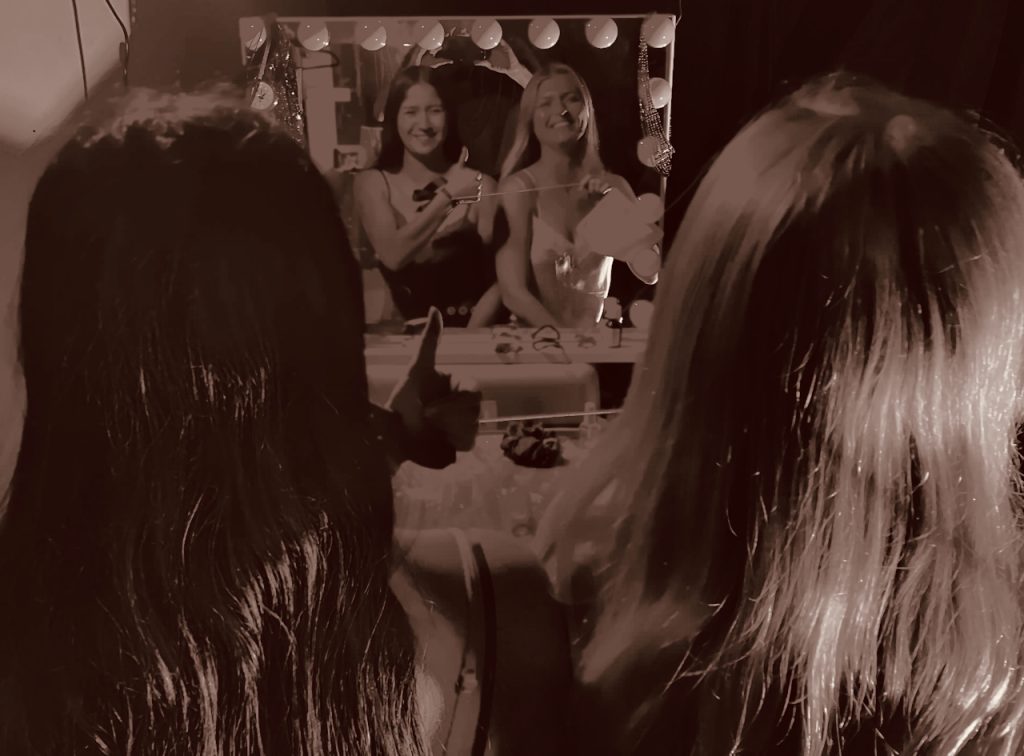
(about 4400 words)
Headnotes
- “We” or “our” refers solely to Kirsten and Aaron, “the team” refers to all five SDF contributors to this event. Aaron wrote most of this post. Kirsten’s comments are underlined in red.
- I took few photos, and fewer still are any good. Almost all the selects are in the showroom or this post.
- We currently don’t intend to remount Stringed Instruments, but that doesn’t mean it won’t happen. This post spoils the whole thing. If you think that at some future point we’ll do a remount, and you are able to see it, and you don’t want to know the plot, maybe skip this post.
From May 2nd to 4th, Spectacular Disaster Factory was honored to be one of eight groups invited to participate in the 2025 Los Angeles Immersive Invitational, which is like a “jam” or 48-hour immersive experience creation fest. This was the fourth Invitational (or fifth, depending on how you count one in Denver), and SDF’s first time participating. The organizing groups were After Hours Theater Company, The Immersive Experience Institute and the generous cooperation and use of the LGBT Center in Hollywood, who would receive half of the ticket proceeds to support their critical work. The other seven participating teams were: Cherry Poppins, Dr3am Logikk, Last Call Theatre, Meanwhile… netprov Studio, The Queen’s Fools, Spies Among Us, and Spy Brunch.
We attended last year’s invitational as audience members, so we roughly knew the structure, which for 2025 was:
- The theme of this year’s event was revealed to all teams around 7:30pm Friday, May 2: music.
- A moment later, team captains blindly picked a vinyl album out of a milk crate that represented a genre of music; the team got electronica.
- Following that, the team captain randomly chose a space (a number taped to the back of a cassette) to stage their experience; the team’s was Area 5.
- Then captains selected a prop to use in the show; I snagged a pink bike light, which seemed to fit with electronica.
With these elements, each team had about 40 hours to create their own 10-minute immersive experience. There would be three shows—each “show” comprises all eight teams’ vignettes—on Sunday, May 4: noon (the previews), 4pm, and 7pm. Each show ran for two hours, with an intermission. During those two hours, audience groups were led by a guide, portraying a DJ from KIIX Immersive Radio, to the eight teams’ musical genre-inspired creations.
There was a light competitive aspect to the Invitational, as both audiences and pseudo-anonymous judges could vote on their favorite shows as well as some other categories like “best use of the space / prop / music.” (In this tight-knit community, we recognized some judges.)
The SDF team is overjoyed to have received both the Audience Choice Award and tied, with Spies Among Us, for the Grand Prize / Judges’ Award. Thank you!
The accolades would not have been achieved without the incredible efforts of our teammates: actors Abigail Corrigan and Tiffany Ogburn, plus production and audio designer Rachel Adams from the Immersive Art Collective.
The creative process involved too much stress, too little sleep, aching muscles, a broken light bulb, a few “firm but thoughtful discussions”, and a hospital visit.
Here’s what happened.
The Before Time
It helped that we saw last year’s Immersive Invitational, so we knew the show would last about 10 minutes and we would probably have a small room to do it in. After we received the invite, I went about recruiting a team.
I almost cast Abigail (Abby) in Temp Cupid (2024), but we didn’t have the budget for another actor. Yet we stayed in touch. Both Abby and her friend, Tiffany (Tiff), had done immersive shows in Colorado, where they relocated from, plus seen some and been in some in LA (e.g., The Narrative Treatment Plant by Mister & Mischief). We met, but hadn’t yet worked together. We were also fortunate to have Rachel Adams, head of the Immersive Art Collective (and The Count’s Den) join us as a production designer and, later, took on the task of DJ/sound designer. We knew we needed a builder on the team, and she’s one of the best. The team was set about a month prior to the Invitational.
I knew Abby and Tiffany were both dancers and friends who had collaborated before, so inspired by those facts, a few weeks before the jam my muse slipped me an idea without warning: human puppets. I envisioned actors with strings attached to them that the audience could manipulate. I call this our “gimmick” and I liked it because:
- It was movement-based to capitalize on Tiff and Abby’s dancing talents.
- As puppets, they wouldn’t talk much if at all, so there was no need to spend time writing a script, memorizing lines, or blocking. Anything that streamlined the show or offloaded to audience agency, the better.
- Costuming could be almost anything.
- It worked in a small space.
- It fits the SDF schtick of allowing audience-participants the ability to interact with the actors, a la One Last Thing Before We Go or Give Up the Ghost. Affecting the actors meant altering the narrative, so I figured there would be four different endings:
- What happens if neither puppet is untied?
- What happens if both puppets are untied
- What happens if puppet A is untied, but not B?
- What happens if puppet B is untied, but not A?
Untying the puppets was always in the plot.
- We felt the gimmick was general enough that it could handle almost any theme the team got from the Invitational—the how and why they are puppets would be determined by the “ingredients” we got. Some ideas for how and why that I had before the Invitational commenced were:
- the puppets were magically cursed
- they wanted to kill each other
- the audience-participants are gods, and the puppets are heroes trying to complete quests
They were none of those things in Stringed Instruments.
The “lore” of the puppets (the how and why) would be explained or hinted at by set dressing and props for the audience to deduce, especially since we needed to give people who weren’t manipulating the puppets something to do.
The ideal moment I hoped to create was while a participant enjoys manipulating a puppet, the puppet would start crying, upset at what is being done to it (or not being allowed to do, in case it wanted to kill the other one). Another participant notices the tears and says “She’s crying! Stop!” And then the audience would argue if it was right to untie them or not.
I crossed my fingers and toes that this gimmick would fit whatever we were handed on Friday. I prepared myself and the team to jettison the puppet idea—which they knew about the day after it popped into my head—if it wouldn’t work with the Invitational assignments, and instead start from square one.
But the team got lucky.
The Ingredients
The eight musical genre options were: classical, folk, showtunes, hip-hop, jazz, pop, rock, and the one we got: electronica.
The eight performance spaces were scattered around the LGBT Center—one was a 50-ish seat black box theater, two were control rooms above a stage, a few were small art gallery rooms, one consisted of two small offices across the hall from each other, etc. We got the space called Studio 5: a storage/green room behind the big theater. The audience would come in and out of 5 through a long hallway. It was geographically (and sonically) separated from all the other spaces being used. Incidentally, as the team explored room five, that’s when a loose light bulb in a box fell and broke.
Fortune smiled on us twice, as both electronica as the genre and area 5 as the space worked together well, and both easily fit the puppet idea; I think we’d be screwed if the team had to use show tunes. Thus we were golden by the end of Invitational’s assignments on Friday night—but then I almost traded it all away.
In the original concept, I pictured the puppets in a small, dark empty room, and I was growing attached to using the puppets with the song “Release” by Pearl Jam (this was before I knew the music theme) because the tune could suggest releasing the puppets, plus its duration is about 9 minutes, including a trippy, ambient, lyric-less outro.
The Dr3am Logikk troupe had a small square space and the genre Rock, so during the hour where teams could swap genre or space, I considered trading Area 5 if they would also trade their genre; that way I could use my beloved Pearl Jam song. I put it to the team, and they voted it down—don’t give up that hallway to the space, that separation from the other teams! Rather than fight for my original vision, we declined the offer to Dr3am Logikk (sorry, Karlie!).
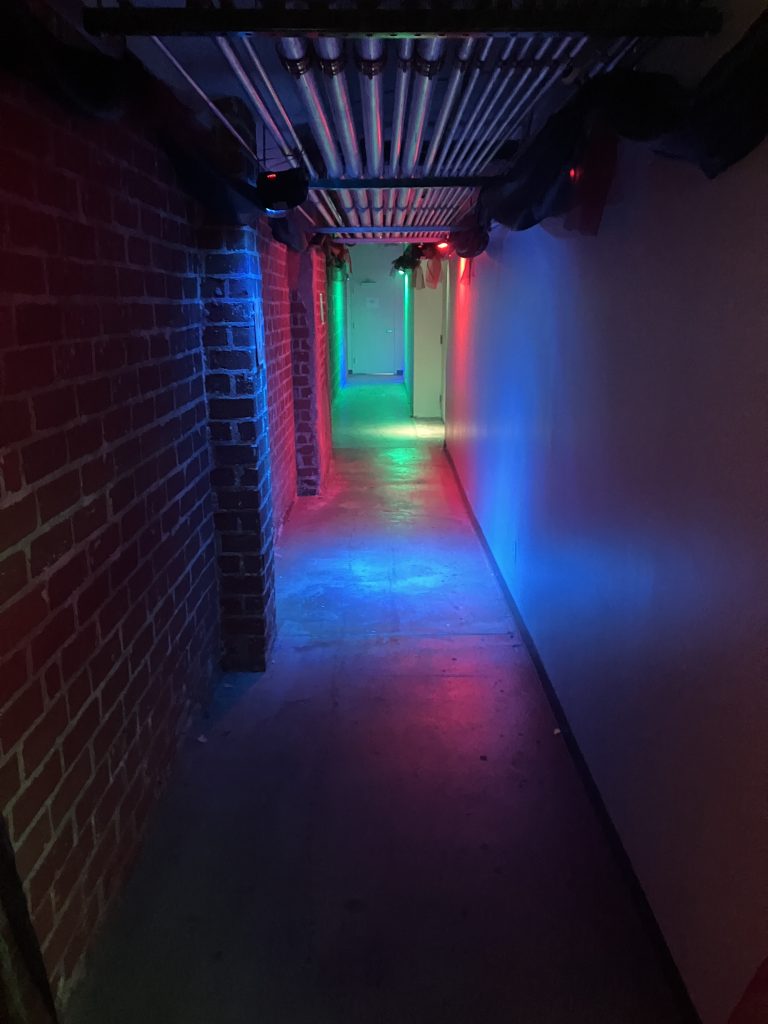
Budget
Each team was given a low three-figure stipend to spend however they wanted. We spent about 25% of it on supplies, about half of which we didn’t need, but we didn’t know at the time we made the purchase. The bulk of the money went to feeding Kirsten and myself Fat Sal’s sandwiches over the weekend, which were $20+ each (!).
We had a little of money left, and Rachel generously donated her share to the cause, so the remainder well-deservedly went to Tiffany and Abigail.
The Process
We were fairly comfortable with what we had when we walked out just before midnight on Friday—but the rest of the team was not.
With the elements in place: electronica, backstage area, puppets, two female characters, it became a show about women at a dance club—and yes, the team had a discussion about strippers and drug addiction. I wanted the “strings” to represent something that was metaphorically tying the characters up, but also enabling them to do things. Something both “good” (it affords you motion) and “bad” (limiting your life). Whatever the strings were, it shouldn’t be the same for both characters.
On Friday night, the plot and characters were pitch dark, which concerned some on the team and, I think, the organizers. By Saturday morning, Abby and Tiffany had better ideas of their characters that lightened the tone a bit, elevating them above the worst stereotypes, and reduced their reservations in portraying them. This development took the show to an PG-13 (or maybe a soft-R) rating: bottle girls at an EDM club, and their “strings” were not addictions. I won’t give it away, but there were clues to indicate each character’s entrapment.
In addition to contributing ideas to plot and characters, Rachel accomplished almost all of the production design herself: dressing the set with high heels and lingerie, lighting the hall, setting up drapes and audio speakers, plus bringing a fog machine (there was a bottle of fog juice in the space, and we were told that the team could use anything in it) and some important props, like makeup, from The Count’s Den. She was unavailable Sunday, but asked someone to strike the set, which was great because he was doing that while the rest of us were at the awards ceremony.
Rachel had the inspiration of playing audio of the characters mixed with an ambient drone, separate from the music we always intended to play. This dovetailed with my desire to have backstory suggested and hinted at through set design and music. On Saturday night we recorded Abby and Tiff improvising chit-chat between their characters plus a few internal monologues that suggested what were the strings that tied them. Rachel edited and mixed the dialogue with a drone into one track, then assembled a playlist and emailed both files to us early Sunday, before the noon previews.
Puppet Strings
In addition to figuring out what the strings represented, we also had to settle on the best physical method of puppet manipulation.
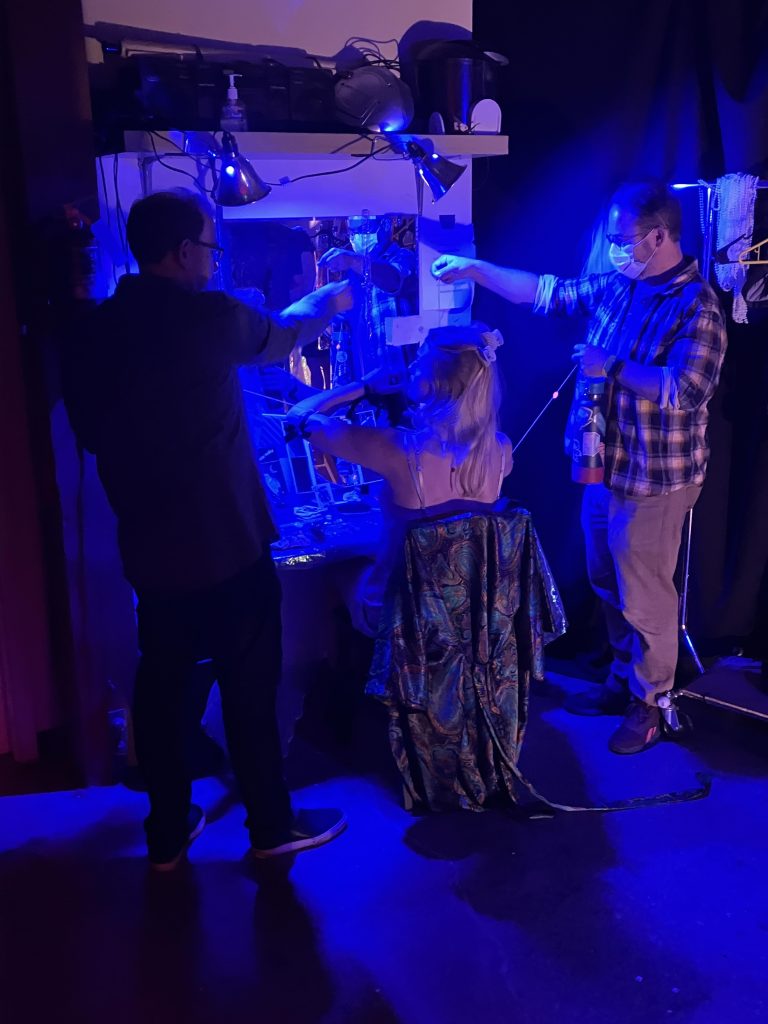
In the original idea, I thought of four strings being attached to four limbs, i.e., two on the wrists, two on the ankles. Audiences would need to work together to move the puppets from one place to another. But a week before the Invitational started I yeeted that idea for what should be obvious reasons. However, I was very concerned that with only four strings (two on each character) for audiences to pull, that left six-plus participants with nothing to do but watch. I expressed that concern to the team on Friday night. I knew some audience members would be OK just observing, but not the majority. Here again Abby and Tiff saved the day, as it was they who suggested, after we did previews on Saturday, of putting a string on their elbow as well as their wrist. That meant more participants could be involved, and it was easier to manipulate the puppet characters; they found it helped them, too.
The other issue we dealt with was deciding the exact material of the strings. I originally wanted it to be glowing lines, easily seen in the dim room. We used something like this in Give Up the Ghost (EL wire), but we didn’t have enough for both characters, and it was too late to order more off Amazon. My next thought was to use Christmas light wire, and IKEA had the best, cheapest option: Vissvass. We tried to make that work in tests and previews, but it didn’t easily wrap or unwrap, and we had the additional problem that audiences weren’t picking up the Vissvass. Probably because they look more like decor than tools.
We solved all these complications by going back to basics with a slight modification: we used black ribbon as the strings, and put neon-colored stickers on the ribbon, to call them out The direction we eventually gave audience-participants was “You can touch anything with a neon sticker on it, and don’t be afraid to pull.”
The ribbon was adjusted so there was a loop tied into a bow around the actors’ wrists and elbows that could be untied (that bow also had a sticker on it, indicating it could be touched), and another ribbon tied to the loop, also with stickers on it, that the audience could tug, i.e., participants would pull a length of ribbon that was tied to a loop of ribbon around the actors wrist or elbow. This cleared an additional concern from the organizers who were worried that using yarn (a prototype I knew we wouldn’t use) would cut off the actors’ circulation.
We also added neon stickers to some objects on the set, like one character’s diary.
Challenges
There were two unexpected challenges to getting Stringed Instruments fully up and running: one technical that was dodged, and one personal that was plowed through.
Rachel—again, who couldn’t be there for Sunday’s shows—set up speakers for a surround sound effect for the drone + dialogue track and another set with a subwoofer for the EDM playlist, but we couldn’t connect playing devices to them through Bluetooth or the ¼-inch plug converter we didn’t have. Mere minutes before previews, we substituted our old laptop Mac to play the dialogue track and, hidden in the hallway, Kirsten’s iPhone and our Jambox speaker for the music. The worst part of this was trying to get the EDM track to play – it refused to open in the Music app. After several minutes of panicked swearing, I finally got it to play…in Merlin, a birdsong identifying app. Of all things. After each run I had to manually scrub back through the track that kept trying to identify what birds EDM sounded like. I didn’t think to look at the answers, if there were any. It wasn’t ideal but it worked, and, as we later discovered, it was good that neither audio track was too loud, so the participants could hear the few spoken words from the characters.
The second challenge was that Kirsten’s mother had a health crisis and went into the hospital on Friday night, so Kirsten drove up to Bakersfield Saturday morning, visited mom in the hospital for an hour, then returned that evening, picking up six Vissvass from IKEA-Burbank, and feeding our cat before coming to Hollywood. Being one creator down through the development process for most of Saturday slowed the team, and the emotional drain to Kirsten also depleted her by the time she arrived to set.
The Title
We needed to reveal the show’s name to the organizers on Saturday night. I thought of Stringed Instruments fairly quickly, and the team accepted it. I liked the idea of including the word “strings” in the name, I liked how there was a musical connection (not sure how many stringed instruments appear in EDM, though), and I like how the characters could be thought of as “instruments”—instruments for what? Played by whom?
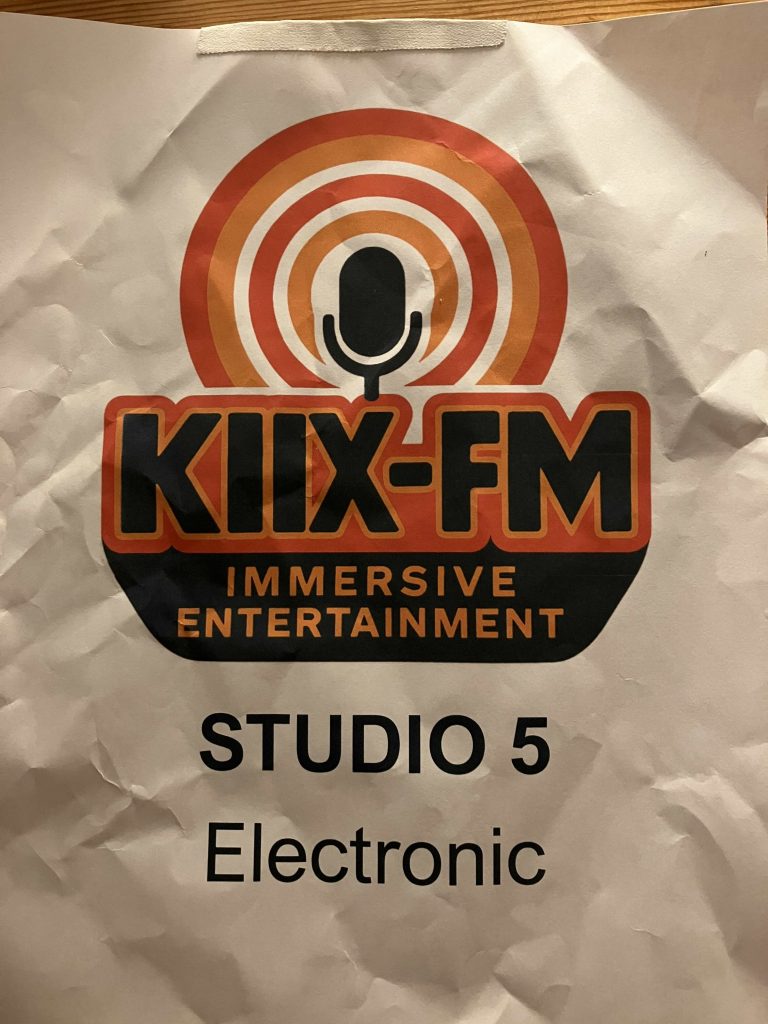
Walkthru (in case you missed it)
Each of the eight audience groups would see all eight vignettes, but the order varied (the groups were called “cars” by the organizers, like a car on rails through a Disneyland ride). Stringed Instruments could be experienced first, last, or somewhere in the middle.
For Studio 5, each car would be guided by their DJ to a closed door. When the team was ready, Kirsten would puff the fog machine and open the door. She’d introduce SDF and explain the rules (see below). She then led the participants down the hallway of fog, colored lights and posters of EDM artists. Electronic music could be heard at the end of the hall.
Audiences arrived in the blue-lit backstage area, with two women wearing negligee slips sitting at facing makeup tables a few feet apart, turning their heads around to look at each other. Throughout, their pre-recorded dialogue played in the background and the EDM music continued in the hall. I soon barged in as a club manager and told the characters that this was a big night, that a DJ from KIIX would be spinning, so SELL SELL SELL that liquor; the bar got a big shipment in before the tariffs. They had about eight minutes to get ready.
Audiences were then left to their devices. Most split up between the characters and started pulling the strings to move the actors’ arms around the table. Both characters would occasionally speak in a monotone for what they wanted: “Lipstick. Lipstick…” to get audiences to maneuver them to the lipstick on the table, then to other objects like a hairbrush, blush, money, etc. (I directed this like Tin Man in The Wizard of Oz muttering “oil can”.)
Tiffany’s character non-verbally tried to get audiences to untie her. This might or might not happen in ten minutes, leading to one of three endings: both are untied, Tiff’s character untied, or neither untied. One performance generated a fourth ending (see below).
Around the ten minute mark I would come back in and tell the girls it was time to go, and Kirsten would lead the audience out the same way they came in.
What we wanted to do but didn’t do
We thought of writing “lore” explanations in blacklight/UV ink on the concert posters hanging in the hallway—audiences would see posters as they came in, but while they were in the room, I would turn blacklights on to reveal the secret messages on their way out. These UV/blacklight clues would reinforce and expand the audio dialogue. But that was way too involved to set up, and I couldn’t think of anything to write on the posters. We also wanted to give each audience member a glowstick (leftovers from Give Up the Ghost) upon exiting, but we forgot that we brought them. Honestly, we wouldn’t have had time in the experience to do this either – more specifically, we needed the audience to be leaving at the end of our scene, not slowing down or stopping to read everything on the way out.
What Happened
Each run improved upon the previous, especially after the team had a two-hour break between the noon preview shows and the first official (judged) show at 4pm. By the 7pm performances, the team was clicking smoothly.
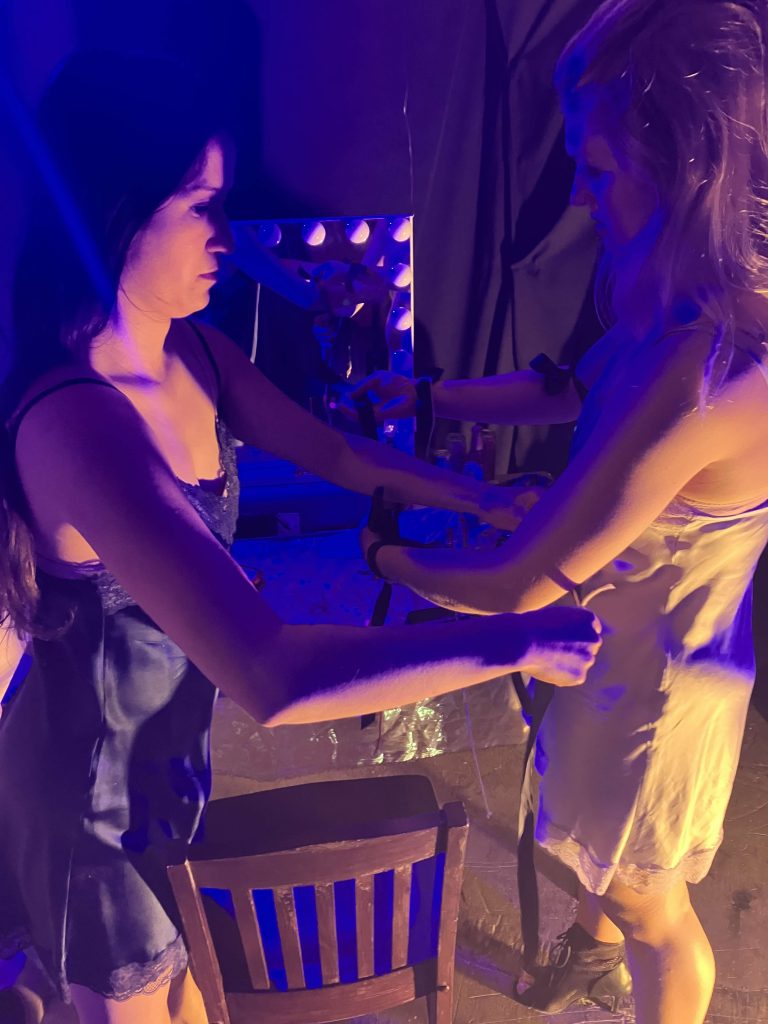
The most important aspect we altered from previews to 4pm was what I call our “mount” and “dismount,” that is, how we introduced audiences to the experience and brought them out of it. Kirsten played what we call a Shadow (the official title of guides from Give Up the Ghost), who explained the rules of the experience. This is a feature of SDF events that we are still tinkering with to find out what works best. On the one hand, we want to be thorough so there aren’t any questions during the performance. On the other hand, we don’t want to take time away from the show. And on a third hand, we try to make the onboarding process part of the show itself. For Stringed Instruments the intro wasn’t integrated into the fiction, but it was, at least, brief. What we are learning is the intro can have a huge effect on how people behave during it. (see below)
It took a few runs, but the ultimate intro that Kirsten recited was: “Hello friends! I will be leading you in and out of the experience. When you hear me say ‘Friends, follow me!’…you should do that. Look for stickers like these” (I had several on my shirt) “to show you the strings by which you will manipulate this experience. Keep your eyes peeled, and never be afraid to pull.”
My acting introducing the scene needed adjusting as well. In the earliest preview runs my character,* the club’s manager, was aggressive and domineering; one early audience member thought I was a pimp. Afterwards I toned my improv down, becoming more positive toward the women and focusing his motivation to making money. I would conclude the experience, too; I was the timer. After the intro I paced outside the room watching the clock. Around 9 minutes in, I’d check with Kirsten, who was monitoring the room, to see if Tiffany’s character was untied or not. I then had to make a judgement call: do I conclude without the puppets untied? How long do I allow audiences a moment to consider untying Abby’s character? Maybe a third of our performances went a little long because the audience was at the climactic moment of choice, and I erred on the side of delaying the ending so they’d get a dramatic finish. In some cases, like with Todd Martens of the LA Times, I had to shoo the audience out.
Side note: this was not the first or even tenth time a participant didn’t want to leave an SDF show and had to be led out. We consider this positive, even though it kinda bungles throughput.
*Both Kirsten and I prefer to not have to perform in our shows, but bodies were needed.
The team did not expect one audience interaction that created a fourth ending: Abby’s character was released almost immediately, and she then had to improvise her character’s tasks and actions for about eight minutes until Tiffany’s character was undone. In that instance, the two characters exited together—the happiest ending? I originally imagined four endings, as noted above, but during the process of encouraging audiences to untie the puppets (next paragraph), we left out the possibility of them untying Abby’s character before Tiffany’s.
One big discussion the team had during and after previews was about audiences not untying the puppets. The actors wanted to make that option more obvious, but we pushed back a little because we don’t like to steer audiences. We follow a Nordic larp mantra of “creating a liminal space that allows you to tell stories about yourself.” To us, it wasn’t wrong if audiences didn’t untie the puppets, that was just the ending you got. The team reached a compromise where Tiffany prompted the untying of her character, but Abby did not. Nor would Abby’s character know what to do if she was untied. Which meant we didn’t expect that fourth ending, above.
As I’ve been thinking about this post, I rationalized this issue a bit more. At the time, we were just following our instincts and past experience. In hindsight, I can explain.
- Many participants didn’t want to violate an actor’s space, or were worried they might hurt them, especially a female actor; some told us as much. That later led Kirsten to give audiences permission when they entered—adjusting the mount, as described above. We think this is interesting, this conundrum between invading someone’s personal space to free them from their bonds, or, if not getting into their space, leaving them tied.
- This was just an experience, a show. If you didn’t untie the puppets, maybe, just maybe, you’ll wish you had, and that provokes the kind of rumination we like our audiences to take with them after they leave.
Some audiences figured out the characters’ backstories and what their strings represented based on the objects on their tables and how the puppets reacted to them, as well as the audio dialogue, but some audiences didn’t—and that’s OK. We are not judges grading the audience based on their actions or inactions. Which segues into the “secret sauce” of Spectacular Disaster Factory.
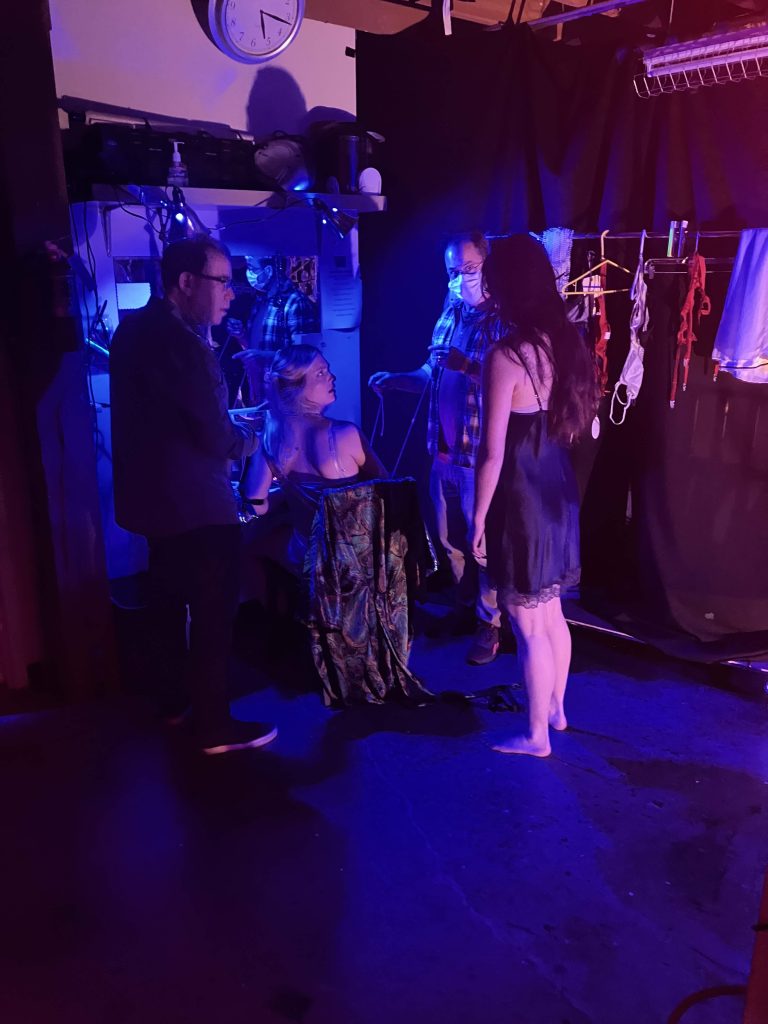
The Spectacular Disaster Factory Secret
Almost every SDF show centers around a question we pose to the audience-participants—sometimes it’s explicit, but in most of our experiences it is more subtle. In the case of Stringed Instruments, it was very faint. Moreover, it evolved a bit from what I originally thought it was, and it wasn’t clear to me until our later performances.
If you saw the show, what do you think the question was?
A frequent comment regarding Stringed Instruments was “I cannot stop thinking about it.” Awesome! To us, this is the greatest compliment we can get. Note that we don’t want to or need to know what your answer is to the question. Nor do we want to tell you an answer, because we don’t feel that it’s our place to resolve these questions for people, to “shove OUR vision” at you. Instead, we just want to provoke a situation where you could teach yourself something about yourself. If not, we still hope you enjoyed our experience.
Do you have questions or remarks about the show? Please leave them in the comments below.
